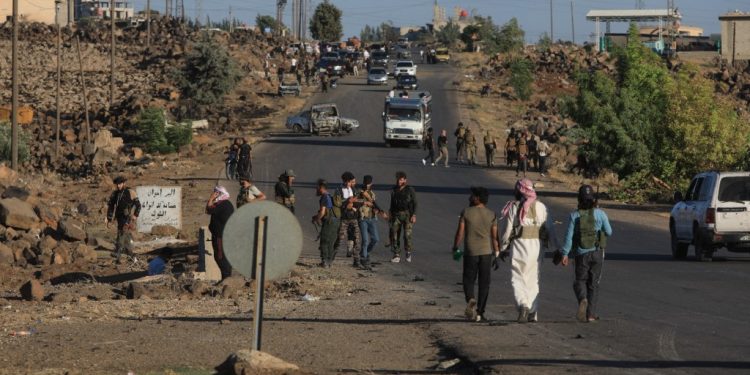The recent evacuation of hundreds of tribal families from Suweida to rural areas of Daraa has stirred intense debate over whether this operation constitutes an urgent humanitarian response or a case of undeclared forced displacement. The move comes on the heels of escalating violence and deteriorating security conditions in Suweida’s countryside.
Raed al-Saleh, Minister of Emergency and Disaster Management, announced that 1,500 civilians—mostly women and children—had been relocated from Suweida to temporary shelters in Daraa. He described the transfer as a “humanitarian response,” coordinated with state institutions. Dozens of the injured were also transported to receive urgent medical care.
Footage aired by Syria TV showed families arriving at the shelters in visibly distressed conditions, recounting stories of sudden gunfire, missing relatives, and attacks on their homes. Many reported fleeing under duress, citing fear, insecurity, direct threats, sieges, and the collapse of basic services in their home areas.
Local testimonies indicate that these evacuations were not entirely voluntary, raising concerns about the circumstances and intentions behind the operation—especially given the absence of any official announcement detailing the agreement that facilitated the exodus.
Legal Ambiguities and Calls for Transparency
Fadel Abdul Ghani, Director of the Syrian Network for Human Rights, told Syria TV that the evacuation cannot be classified as legal in the absence of a publicly disclosed agreement. He urged the Syrian government to release the full text of any such agreement to allow legal experts to determine whether the operation constitutes forced displacement.
“The legal classification depends on clarity,” Abdul Ghani said. “Terms like ‘forced displacement’ or ‘mass exodus’ should not be used lightly without knowing the context and the precise mechanisms that triggered the evacuation.”
He acknowledged that some accounts suggested the evacuations were a protective measure, prompted by an inability to control armed groups and a fear of retaliatory violence. If temporary and designed to ensure safety, such actions could be permissible under international law, he noted. However, if the relocations prove permanent and lack guarantees of return, they could constitute a serious violation of international legal standards.
Abdul Ghani warned that this episode evokes earlier chapters of the Syrian conflict, where displacement often led to indefinite exile without protection or restitution for affected civilians.
A Politically Charged Move?
The timing of the evacuation has also raised eyebrows amid reports of a potential three-way understanding involving Damascus, Tel Aviv, and Washington. While details remain murky, speculation is mounting about the broader political context of the Suweida developments.
A Fragile Truce or Prelude to Further Conflict?
Saba Abdul Latif, a researcher at the Omran Center for Strategic Studies, told Syria TV that initial indications suggest the evacuation may be part of a broader, unofficial agreement that has so far reduced violence and facilitated the removal of vulnerable populations from conflict zones.
She warned, however, that the agreement appears to contain two contradictory elements. On one hand, the relative calm and mutual guarantees could lead to a genuine de-escalation effort. On the other, the current truce may follow the familiar Syrian pattern of short-lived ceasefires followed by renewed violence and deepening crises.
If the former scenario holds, Abdul Latif said, it could pave the way for gradual stabilization, however difficult that path may be. If the latter prevails, Syria risks descending into another wave of bloodshed—further prolonging the tragedy.
On the question of tribal displacement, Abdul Latif emphasized that if the evacuation is genuinely temporary and accompanied by real guarantees of return, it may be defensible from a security standpoint. Without such assurances, however, the move risks becoming another case of demographic engineering, stripping Suweida of a vital social component and replicating previous patterns of forced displacement.
Government Assurances
In Daraa, Governor Anwar al-Zoubi said the province had mobilized resources to support evacuees from Suweida, stressing that the relocation was temporary and that the government intended to return families to their homes once conditions stabilize. He added that 30 shelter centers were operational and functioning in coordination with service institutions and aid organizations.
Suweida Governor Mustafa al-Bakkour also visited the shelters in Daraa to assess conditions and oversee relief efforts. He appealed for calm and restraint, urging all parties to work toward reconciliation and the return of displaced families.
“In our meetings, people told us they want to go home—they do not want to remain displaced,” he said. “We told them: You are guests now, but you will return to the homes where you were born, raised, and lived. You are part of this province—part of this land.”
As the situation in Suweida continues to unfold, questions remain about the true nature of the evacuations and whether they represent a temporary humanitarian measure or signal a deeper and more troubling transformation of the region’s demographic and political landscape.
This article was translated and edited by The Syrian Observer. The Syrian Observer has not verified the content of this story. Responsibility for the information and views set out in this article lies entirely with the author.


